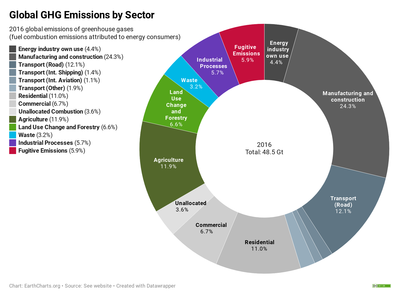Fossil fuel and biomass combustion. Carbon dioxide is the greenhouse gas you hear people talk about the most.
 Greenhouse Gas Emissions Wikipedia
Greenhouse Gas Emissions Wikipedia
Greenhouse gas any gas capable of absorbing infrared radiation net heat energy emitted from Earths surface and reradiating it back to Earths surface thus contributing to the phenomenon known as the greenhouse effect.

What is the most common greenhouse gas. These gases are released during the combustion of fossil fuels such as coal oil and natural gas. Futtsu Thermal Power Station near Tokyo. Deforestation and intensive agriculture also contribute greenhouse gas emissions but not nearly as much as fossil fuel production which accounts for 75 per cent of greenhouse gas emissions in North America.
On the other hand warmer air can hold more water vapor without causing a rainstorm. The greenhouse gases that humans do emit directly in significant quantities are. There are seven greenhouse gases that contribute directly to climate change.
Carbon dioxide CO2 methane CH4 nitrous oxide N2O hydrofluorocarbons HFCs perfluorocarbons PFCs sulphur hexafluoride SF6. As a result the climate is changing worldwide. Carbon dioxide CO 2 makes up the vast majority of greenhouse gas emissions from the sector but smaller amounts of methane CH 4 and nitrous oxide N 2 O are also emitted.
They let sunlight pass through the atmosphere but they prevent the heat that the sunlight brings from leaving the atmosphere. The main greenhouse gases are. Generating electricity and heat by burning fossil fuels like coal natural gas and oil produces more greenhouse gas GHG emissions than any human activity accounting for at least one quarter of all global emissions.
Thats because we produce more carbon dioxide than any other greenhouse gas and its responsible for most of the warming. Since the Industrial Revolution rising emissions of greenhouse gasesincluding carbon dioxide methane nitrous oxide and othershave been the driving force behind climate change. Carbon dioxide methane and water vapor are the most important greenhouse gases.
The answer may not be as clear as one might assume because the top emitters change depending on how the data is collected and what numbers. These five gases account for about 96 of the direct radiative forcing by long-lived greenhouse gases since 1750. Global average abundances of the major well-mixed long-lived greenhouse gases - carbon dioxide methane nitrous oxide CFC-12 and CFC-11 - from the NOAA global air sampling network are plotted since the beginning of 1979.
That change has increased the severity and frequency of storms heat waves wildfires and. Carbon dioxide enters the atmosphere through burning fossil fuels coal natural gas and oil. Methane is emitted during the production and transport of coal natural gas and oil.
People produce larger amounts of some greenhouse gases than others. Carbon Dioxide Share of Global GHG Emissions. The most common greenhouse gas is actually water vapor like in clouds.
These gases are therefore known as greenhouse gases GHG. Sources and Concentrations of Major Greenhouse Gases. But because water vapor quickly leaves the atmosphere as rain we dont have to worry about our water emissions.
Accounts for around three-quarters of the warming impact of current human greenhouse-gas. Greenhouse gases are gases in Earths atmosphere that trap heat. Who is responsible for emitting the most greenhouse gases.
Overview of Greenhouse Gases Carbon dioxide CO2. 187 rows For only carbon dioxide see List of countries by carbon dioxide emissions.








